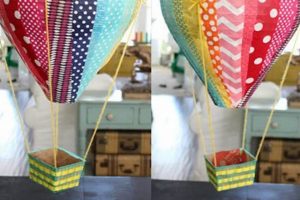The creation of sound-absorbing wall treatments through do-it-yourself methods offers a cost-effective solution for managing reverberation and improving acoustic clarity within a space. This approach involves utilizing readily available materials and construction techniques to fabricate panels that effectively reduce sound reflections. An example includes constructing a frame, filling it with mineral wool or fiberglass insulation, and covering it with fabric.
This practice presents several advantages, including significant cost savings compared to commercially manufactured options. Furthermore, it allows for customization of size, shape, and aesthetic design to seamlessly integrate with existing decor. Historically, resourcefulness in addressing acoustic challenges has led to various iterations of these solutions, evolving from basic fabric hangings to more sophisticated, engineered constructions.
The following discussion will explore the key aspects of constructing effective sound-absorbing wall treatments, including material selection, frame construction techniques, fabric covering methods, and considerations for optimal placement within a given environment. It will delve into the specific characteristics of various materials and their impact on acoustic performance, providing practical guidance for achieving desired sound control outcomes.
Practical Guidance for Constructing Sound-Absorbing Wall Treatments
The following guidelines provide practical recommendations for achieving optimal performance when constructing sound-absorbing wall treatments. Careful consideration of these points will contribute to effective sound management within a designated space.
Tip 1: Material Selection is Paramount: Employ dense, porous materials such as mineral wool or fiberglass insulation for the core of the panel. These materials effectively convert sound energy into heat through friction, maximizing absorption.
Tip 2: Frame Construction Considerations: Construct a rigid frame using wood or a similar sturdy material to provide structural support for the absorbent core and fabric covering. Ensure the frame is square and provides adequate depth for optimal low-frequency absorption.
Tip 3: Fabric Choice Influences Performance: Select a breathable fabric that allows sound waves to penetrate the panel without significant reflection. Open-weave fabrics, such as burlap or acoustic-specific textiles, are generally preferable to tightly woven materials.
Tip 4: Air Gap Enhancement: Incorporate an air gap between the panel and the wall to improve low-frequency absorption. A small space, even a few inches, can significantly enhance performance at lower frequencies.
Tip 5: Secure and Stable Mounting: Utilize appropriate mounting hardware to ensure the panels are securely and stably affixed to the wall. Consider factors such as wall material and panel weight when selecting mounting methods.
Tip 6: Strategic Placement for Optimal Results: Position the panels strategically to address primary reflection points within the room. Identify these points through acoustic analysis or by observing where sound reflections are most pronounced.
Tip 7: Density and Thickness Impact Absorption: Thicker and denser panels generally offer superior absorption across a broader frequency range. Experiment with different thicknesses to achieve desired acoustic characteristics.
Adhering to these recommendations will facilitate the creation of effective and aesthetically pleasing sound-absorbing wall treatments, contributing to improved acoustic conditions within the treated environment.
The subsequent section will provide a concluding summary, reinforcing the key benefits and considerations associated with this approach to sound management.
1. Material Sound Absorption
Material sound absorption constitutes a foundational element in the effective implementation of do-it-yourself acoustic panels. The inherent capacity of a material to dissipate sound energy significantly determines the panel’s overall performance in reducing reverberation and improving acoustic clarity within a defined space.
- Porous Absorbers: Mechanism of Action
Porous absorbers, such as mineral wool, fiberglass, and open-cell foam, attenuate sound waves by converting acoustic energy into heat through frictional resistance. Sound waves entering the material cause air particles within the pores to vibrate. This vibration generates friction as air molecules interact with the material’s structure, dissipating energy as heat. In sound-absorbing panel construction, the selection of porous materials with high airflow resistivity is crucial for optimal absorption coefficients across a range of frequencies.
- Density and Thickness: Impact on Performance
The density and thickness of the absorptive material directly influence its sound-absorbing capabilities. Higher density materials generally offer improved absorption, particularly at lower frequencies. Similarly, increasing the thickness of the panel provides a longer path for sound waves to travel through the material, resulting in greater energy dissipation. In panel fabrication, these parameters must be carefully calibrated to achieve the desired acoustic response for a specific application.
- Material Selection Criteria: Practical Considerations
Beyond acoustic properties, practical considerations such as cost, availability, and ease of handling factor into material selection. Mineral wool and fiberglass are common choices due to their relatively low cost and readily accessible supply chains. However, handling these materials requires appropriate safety precautions, including the use of personal protective equipment to prevent skin and respiratory irritation. Alternative materials, such as recycled denim or cellulose, offer environmentally friendly options, albeit potentially at a higher cost or with varying acoustic performance characteristics.
- Frequency-Dependent Absorption: Material Response
The effectiveness of a material in absorbing sound varies with frequency. Lower frequencies, characterized by longer wavelengths, require thicker and denser materials for effective absorption. Conversely, thinner and less dense materials may be sufficient for absorbing higher frequencies. Understanding the frequency-dependent absorption characteristics of different materials is essential for designing sound-absorbing panels that address specific acoustic challenges within a given environment. This understanding allows targeted selection of materials to mitigate problematic frequencies, leading to a more balanced and controlled acoustic environment.
The interplay of these facets underscores the importance of informed material selection in do-it-yourself acoustic panel construction. By carefully considering the acoustic properties, practical considerations, and frequency-dependent response of various materials, individuals can create effective and tailored solutions for managing sound reflections and enhancing aco
ustic quality.
2. Frame Structural Integrity
Frame structural integrity is a fundamental component of successful do-it-yourself acoustic panel construction. The frame provides the necessary support for the absorptive material and fabric covering, maintaining the panel’s shape and preventing sagging or deformation over time. Inadequate structural integrity can lead to panel failure, compromising acoustic performance and aesthetic appeal. For example, a poorly constructed frame may warp under the weight of dense absorptive material, creating gaps that diminish sound absorption. Conversely, a robust frame ensures the panel remains taut and uniform, maximizing its surface area for sound absorption.
The selection of appropriate materials and construction techniques directly influences frame structural integrity. Wood, due to its strength and availability, is a common choice. However, the wood’s type and dimensions must be carefully considered based on the panel’s size and the weight of the infill. Improper joinery or the use of insufficient fasteners can result in a weak frame that is prone to failure. In practical applications, reinforced corners and strategically placed cross-bracing enhance the frame’s resistance to warping and bending. For instance, larger panels intended for bass trapping often require more substantial framing to withstand the increased weight and pressure.
Ultimately, prioritizing frame structural integrity in do-it-yourself acoustic panel projects ensures long-term performance and aesthetic consistency. Neglecting this aspect can result in panels that degrade over time, necessitating costly repairs or replacements. By investing in quality materials and employing sound construction practices, individuals can create acoustic panels that effectively manage sound and maintain their structural integrity for years to come. The connection between frame integrity and panel longevity is undeniable, reinforcing the importance of careful planning and execution in this aspect of acoustic panel construction.
3. Fabric Acoustic Permeability
Fabric acoustic permeability plays a critical role in the performance of do-it-yourself acoustic panels. The fabric serves as the outermost layer, directly interfacing with the sound waves and significantly influencing the panel’s ability to absorb sound effectively. The degree to which a fabric allows sound waves to pass through it, rather than reflecting them, dictates its suitability for use in acoustic panel construction.
- The Importance of Airflow Resistance
Airflow resistance, a measurable property of fabrics, quantifies the ease with which air can pass through the material. Low airflow resistance is generally desirable for acoustic panel fabrics. Tightly woven fabrics with high airflow resistance can impede sound waves, causing them to reflect off the panel’s surface rather than penetrating the absorptive core. Examples of suitable fabrics include burlap, acoustic cloth specifically designed for sound absorption, and loosely woven linen. Conversely, vinyl or tightly woven polyester are generally unsuitable due to their high airflow resistance.
- Impact on Frequency Response
Fabric acoustic permeability affects the frequency response of acoustic panels. Highly permeable fabrics allow a wider range of frequencies to reach the absorptive core, resulting in more uniform absorption across the frequency spectrum. Less permeable fabrics tend to attenuate higher frequencies more significantly, leading to a skewed frequency response. In do-it-yourself projects, selecting the appropriate fabric can help tailor the panel’s performance to address specific acoustic issues within a room, such as reducing harsh reflections or taming excessive reverberation in a particular frequency range.
- Aesthetic Considerations vs. Acoustic Performance
While aesthetic considerations are important in do-it-yourself projects, prioritizing acoustic performance is crucial. Some fabrics may be visually appealing but acoustically detrimental. For example, a thick, densely textured fabric might add a desired aesthetic element but significantly reduce the panel’s sound absorption capabilities. In such cases, a compromise may be necessary, or an alternative fabric with similar aesthetic qualities and better acoustic permeability should be sought. Testing fabric samples for airflow resistance and acoustic transparency before committing to a particular material is advisable.
- Fabric Mounting Techniques and Their Effects
The method used to mount the fabric onto the panel frame can also influence acoustic permeability. Stretching the fabric too tightly can reduce its permeability by compressing the weave. Conversely, leaving the fabric too loose can result in unwanted vibrations or resonances. A balanced approach, ensuring the fabric is taut but not excessively stretched, is generally recommended. Additionally, using staples or other fasteners sparingly and strategically can minimize any potential impedance to sound wave transmission.
The facets detailed above demonstrate the interconnectedness of fabric acoustic permeability with the overall performance and aesthetic considerations in do-it-yourself acoustic panel projects. Careful selection and appropriate mounting techniques are essential for maximizing the effectiveness of these panels in managing sound and improving the acoustic environment.
4. Air Gap Optimization
The incorporation of an air gap behind do-it-yourself acoustic panels represents a significant opportunity to enhance their low-frequency absorption characteristics. This strategic design element leverages the principles of wave mechanics to improve acoustic performance without necessarily increasing the panel’s overall thickness or material cost. The air gap, acting as a resonant cavity, alters the impedance matching between the panel and the surrounding air, allowing for greater energy absorption at specific frequencies. A practical example is observed in home studios, where panels mounted directly against walls often exhibit limited effectiveness in absorbing low-frequency sounds, such as those produced by bass instruments. Introducing an air gap behind these panels can substantially reduce standing waves and improve bass clarity.
The size of the air gap directly influences the frequency at which maximum absorption occurs. Larger air gaps generally shift the peak absorption frequency lower, while smaller gaps affect higher frequencies. In practical terms, this means that individuals can tailor the air gap to address specific acoustic issues within their environment. For instance, in a listening room plagued by a 100 Hz resonance, an air gap calculated to target that frequency would yield a noticeable improvement in acoustic quality. Achieving this requires careful consideration of the room’s dimensions and the specific frequencies causing concern. Furthermore, the type of wall behind the panel also affects the sound absorption.
In conclusion, air gap optimization constitutes a valuable technique within do-it-yourself acoustic panel construction. By strategically employing this method, i
ndividuals can achieve improved low-frequency absorption, enhance the overall acoustic performance of their panels, and address specific acoustic challenges within their environment. However, achieving optimal results requires a thorough understanding of acoustic principles and careful attention to design parameters. The integration of this approach directly correlates to a successful diy soundproofing project.
5. Placement Reflection Points
The effectiveness of do-it-yourself acoustic panels is directly contingent upon their strategic placement in relation to reflection points within a room. These reflection points are locations where sound waves bounce off surfaces, contributing to reverberation, comb filtering, and reduced clarity. Acoustic panels placed at these points mitigate these issues by absorbing sound energy rather than allowing it to reflect. A fundamental understanding of reflection point identification is therefore crucial for optimizing the performance of any DIY acoustic treatment.
A common method for identifying reflection points involves the “mirror trick.” An assistant moves a mirror along a wall or ceiling while the listener remains seated in the primary listening position. When the listener can see a loudspeaker’s reflection in the mirror, that location represents a primary reflection point. Placing an acoustic panel at this location effectively intercepts the sound wave before it can create unwanted reflections. For example, in a home recording studio, reflection points on side walls near the mixing position are often treated with acoustic panels to minimize lateral reflections that can distort stereo imaging. Similarly, treating ceiling reflection points above the listening position can reduce early reflections that muddy the perceived soundstage.
Accurate identification and treatment of reflection points represent a critical aspect of achieving desired acoustic outcomes with DIY panels. While constructing high-quality panels is essential, improper placement renders them significantly less effective. Therefore, attention to identifying and treating these locations is paramount to realizing the full potential of DIY acoustic solutions. Neglecting this aspect ultimately diminishes the investment in materials and construction time, resulting in suboptimal acoustic improvements.
6. Cost Material Availability
The feasibility of constructing acoustic panels through do-it-yourself methods is significantly influenced by the interplay between material costs and their accessibility. The economic viability of a DIY approach hinges on securing materials at a price point lower than commercially manufactured alternatives, while their ready availability ensures project completion within a reasonable timeframe. For instance, if high-performance acoustic foam is prohibitively expensive or requires lengthy shipping delays, individuals may opt for more readily accessible and affordable options like mineral wool, sacrificing some acoustic performance for practicality. Therefore, the practical success of “acoustic panels diy” hinges on a careful evaluation of “Cost Material Availability.”
The selection of materials directly impacts the acoustic performance of the final panel. High-end materials like specialized acoustic fabrics or dense fiberglass insulation can offer superior sound absorption coefficients, but their cost may be a limiting factor for budget-conscious individuals. Conversely, readily available and cost-effective alternatives, such as burlap or recycled denim, can provide adequate acoustic performance for many applications. However, their effectiveness may vary depending on the specific frequencies that require attenuation. Consider a scenario where a homeowner aims to improve the acoustics of a home theater. They might find that commercially available acoustic foam tiles offer superior performance but are beyond their budget. Instead, they might choose to build panels using readily available lumber for framing, mineral wool insulation, and inexpensive fabric to cover the panels. While the performance might not match that of the professional-grade tiles, the DIY panels offer a cost-effective solution for improving the room’s acoustics.
Ultimately, the practicality of “acoustic panels diy” is directly tied to the availability of materials and their associated costs. A judicious balance between budget constraints, material accessibility, and desired acoustic performance is critical. While high-end materials can yield superior results, cost-effective alternatives can provide significant improvements in acoustic quality, making the DIY approach a viable option for a wide range of individuals. Understanding and navigating the relationship between “Cost Material Availability” is therefore paramount for a successful DIY project. This relationship is linked to practical factors such as geographic location and access to home improvement stores or online retailers.
Frequently Asked Questions
The following addresses commonly asked questions regarding the construction and implementation of acoustic panels through do-it-yourself methods. The aim is to provide factual and objective responses based on established acoustic principles.
Question 1: What is the optimal thickness for do-it-yourself acoustic panels to effectively absorb low frequencies?
The effective absorption of low frequencies necessitates a panel thickness commensurate with the target wavelengths. Generally, a minimum thickness of 4 inches (10 cm) is recommended for panels intended to attenuate frequencies below 250 Hz. Greater thicknesses, such as 6 inches (15 cm) or more, may be required for optimal absorption of frequencies below 100 Hz. The specific thickness should be calculated based on the target frequency and the acoustic properties of the chosen absorbent material.
Question 2: What type of fabric is most suitable for covering acoustic panels, and what properties should be considered?
Fabrics with low airflow resistance and high acoustic transparency are preferred. Open-weave fabrics such as burlap, linen, or dedicated acoustic cloth allow sound waves to penetrate the panel with minimal reflection. Tightly woven fabrics, such as vinyl or heavy canvas, are generally unsuitable due to their high reflectivity. The fabric’s weight and weave density should be considered to ensure it does not significantly impede sound wave transmission.
Question 3: Is an air gap behind acoustic panels necessary, and how does it affect their performance?
An air gap behind acoustic panels can significantly enhance their low-frequency absorption characteristics. The air gap acts as a resonant cavity, altering the impedance matching between the panel and the surrounding air. The depth of the air gap should be optimized based on the target frequency. Generally, larger air gaps improve absorption at lower frequencies.
Question 4: What is the most cost-effective material for filling acoustic panels while maintaining adequate sound absorption?
Mineral wool and fiberglass insulation are commonly used as cost-effective fill materials for acoustic panels. These materials offer a balance of sound absorption performance, availability, and affordability. However, it is imperative to handle these materials with appropriate safety precautions, including the use of personal protective equipment such as
gloves, masks, and eye protection.
Question 5: How should acoustic panels be positioned within a room to achieve optimal sound control?
Strategic placement of acoustic panels at primary reflection points is crucial. These points can be identified using the “mirror trick” or through acoustic analysis software. Panels should be positioned to intercept sound waves before they reflect off hard surfaces such as walls, ceilings, and floors. Treating corners of the room is also effective for addressing low-frequency issues.
Question 6: What safety precautions should be taken when constructing and installing acoustic panels?
When handling materials such as mineral wool or fiberglass insulation, it is essential to wear appropriate personal protective equipment to prevent skin and respiratory irritation. Ensure adequate ventilation during construction and installation. Use caution when working with power tools and follow all safety guidelines. When mounting panels to walls or ceilings, use appropriate hardware and techniques to ensure they are securely fastened and will not pose a safety hazard.
In summary, the construction and placement of effective do-it-yourself acoustic panels require a thorough understanding of acoustic principles, careful material selection, and adherence to safety guidelines. The information provided addresses key considerations for achieving desired acoustic outcomes.
The subsequent section will delve into advanced techniques for optimizing acoustic panel performance.
Concluding Remarks on Acoustic Panels DIY
The preceding analysis has elucidated the key factors influencing the successful implementation of sound-absorbing wall treatments through do-it-yourself methods. Material selection, frame integrity, fabric permeability, air gap optimization, strategic placement at reflection points, and cost-effective material acquisition represent critical considerations for achieving desired acoustic outcomes. A thorough understanding of these elements is essential for maximizing the effectiveness of DIY acoustic panel projects.
The judicious application of the principles outlined herein offers a practical and economically viable approach to improving acoustic environments. Further exploration into advanced acoustic measurement techniques and customized panel designs will undoubtedly yield even more refined sound control solutions. Diligence in addressing these elements will create comfortable and professional acoustic spaces.







